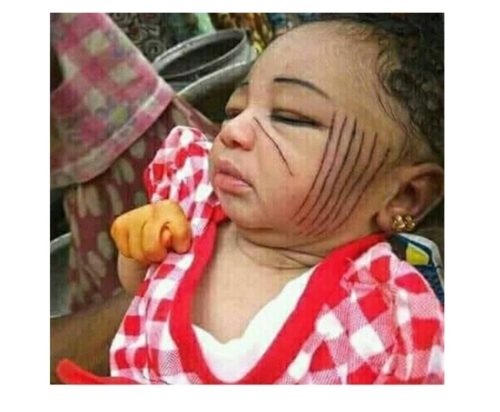This Picture really got me wondering how the practice of tribal marks began in Nigeria, what was the motive behind it, was it a fashion trend, a beauty mark, for identification or trade? My discoveries will wow you.
Tribal marks are specific marks which comes in different shapes and sizes, commonly found on the face; which gives it another name of “facial marks”.
According to history, tribal marks practice in Nigeria dates back to the colonial era when the colonial masters were capturing people and taking them to foreign countries for slavery. People started giving family members marks to identify and recognise them when if they were captured and later found.
Thus, these permanent marks became ways of identification passed on from family to family, members of the same village, identification of royal lineage and people from the same lineage. Different lineage, town, and village have different tribal marks, some with similarities and some totally different.
Reasons For Tribal Marks
Like mentioned above, tribal marks were mainly for identification. At some point in history, every clan/village have their distinct tribal marks and that made it easy for either of them to identify their kith and kin in the event of invasion, war, getting lost, or been captured for slavery.
But later, it became a form of creativity and tattoos on bodies, especially the women. In fact, at some point, women with better looking were valued possessions and were more expensively married.
Tribal marks are mostly given to people at a very young age most especially when they are babies. This is because, at that age, the child doesn’t have a say on decisions to giving him/her tribal marks.
The people who make these marks use either razor blades or sharp knives to cut the face and they have native dye, pigmentation or black paste usually from grounded charcoal dust which is put into the open wound to stain the marks, stop the bleeding and to make the wound
Types of Tribal Marks
Since tribal marks are used mainly to differentiate ethnic groups, they vary. There are marks on the cheeks, forehead, on the temple, under the chin and so on.
These marks can be in vertical lines, horizontal, or both. They could also come in slanted lines on both cheeks. These marks are in patterns based on the ethnic group of their bearer and have different meanings and different names.
Yoruba tribal marks is really an interesting feature of Yoruba nation; although no longer common or in vogue, it is fast disappearing due to extant laws, and international campaign.
There are various tribal marks, by different ethnic groups within the Yoruba nation: Ijesa (a town in Osun state) people are known by “pele.” Pele is a-four-horizontal-line; an-inch-long mark made on the cheeks on both sides of the mouth.
The Ondo natives of Ondo State are identified by half-an-inch-vertical lines on both sides of the nose down to the mouth (marks are thick and long) called “Soju”. Another tribal mark which can also be found in Ondo state is called “Jaju” which is just a single horizontal line on both sides of the face.
Other Yoruba ethnic groups have different types of facial marks; Ogbomosho natives of (Oyo State) are identified by multiple straight marks drawn from the head which curves on the lower chin straight to the corner of the mouth on both sides of the face called “Gombo”
Also prone to Ibadan, Oyo town and the Ogbomosho People (all these three towns are located in Oyo State) is a tribal mark called Abaja. Abaja is made up of four horizontally drawn lines with two or more vertical lines standing on the topmost horizontal line. Other Yoruba tribal marks
Other types of tribal marks that exist among the Yorubas includes Ture, Bamu, Keke, among others.
In Igboland, tribal marks were scarification process is called igbu ichi, and scar called ‘ichi’. However, tribal marks in Igboland cannot be compared to that of the Yorubas as they were much smaller in size and fewer in number of markings.
Like the Yorubas, the Hausas also have names for tribal marks like zube, yan baka, doddori, bille and so on.

WE ARE NOW AUCTIONING IMPOUNDED VEHICLES AND BAGS OF RICE FOR SALE IN A CHEAP AND AFFORDABLE AUCTION PRICES, AND CUSTOM RECRUITMENT FORM ARE NOW AVAILABLE ON SALE, INTERESTED BUYER SHOULD CALL SUNDAY GODWIN 08101780516
SOME LIST OF IMPOUNDED VEHICLES AND THEIR AUCTION PRICES:-
GOIF2 ₦150,000
GOIF3 ₦200,000
GOIF4 ₦300,000.
Toyota Camry ₦400,000
Toyota Corolla ₦400,000.
Toyota 4Runner ₦750,000
Toyota Avalon ₦500,000
Toyota Highlander ₦680,000
Toyota Matrix ₦560,000
Toyota Rav4 ₦700,000
Toyota Sequoia ₦800,000
Toyota Tacoma ₦800,000
Toyota Tundra ₦700,000
Toyota Yaris ₦550,000
Honda Baby Boy ₦420,000
Honda Accord EOD ₦400,000
Honda City ₦450,000
Honda Crosstour ₦850,000.
Honda CR-V ₦700,000.
Honda Odyssey ₦650,000
Honda Pilot ₦800,000
Lexus RX300 ₦600,000
Lexus RX320 ₦700,000
Lexus RX350 ₦850,000
Land Rover Discovery ₦1.2Million
Land Rover Freelander ₦1.2Million
Land Range Rover Sport ₦1.5Million
Acura MDX ₦600,000
Audi A4 ₦450,000
Audi A6 ₦650,000
Mazda 626 ₦4500,000
Mazda MPV ₦540,000
Mercedes-Benz C-Class ₦450,000
Mercedes-Benz E-Class ₦500,000
Mercedes-Benz GLK ₦700,000
Mercedes-Benz ML320 ₦600,000
Mercedes-Benz ML350 ₦850,000
Nissan Altima ₦520,000
Nissan Armanda ₦580,000
Nissan Maxima ₦650,000.etc. Call SUNDAY GODWIN 08101780516
FOR MORE EXCLUSIVE VEHICLES ETC
NOTICE: OUR DELIVERING HERE IS NATION WIDE..+2348101780516……..
Buy Dangote Cement at a promo price of #1000 naira per
bag and a bag of rice for 7,500 naira per bag directly from
the factory,Call the Head of Sales Otunbo B Williams 0n 07036494859
for purchase and delivery. Delivery is #300 and #500 per bag
of cement and rice respectively. Customers can purchase a
minimum of 100 bags for cement and 10bags for rice.